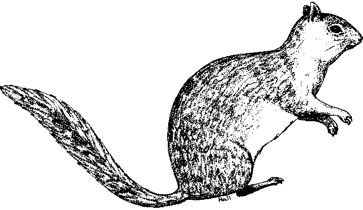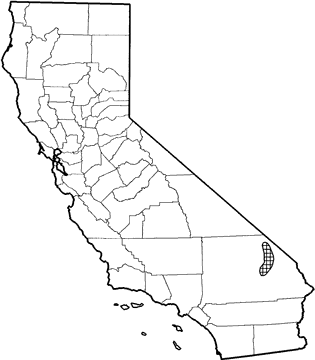
Rock Squirrel
Distribution, Abundance, and Seasonality
In California, the rock squirrel is restricted to the Providence Mts., San Bernardino Co., although it is widely distributed in the southwestern U.S. and Mexico. Prefers rocky outcrops in pinyon-juniper and Joshua tree habitats, and occasionally observed in desert scrub habitat (Hall 1946, Johnson et al. 1948, Ingles 1965, Oaks et al. 1987). Found from 1200-2300 m (3800-7300 ft).

Range Map
Specific Habitat Requirements
Feeding: Eats a variety of seeds and fruits, including juniper, cactus, mesquite, agave, currants, grasses, and pine nuts. Also eats bird eggs and young. Forages on the ground and by climbing trees and shrubs (Olin 1975, Whitaker 1980).
Cover: Uses burrows and dens among rocks for shelter.
Reproduction: Dens in a burrow under or among rocks. May use hollow trees.
Water: Probably does not require drinking water, but drinks if water is available (Olin 1975).
Pattern: Prefers rocky outcrops, talus, and cliffs in pinyon-juniper and Joshua tree woodlands. Outcrops near grassy areas are preferred for feeding.
Species Life History
Activity Patterns: Active yearlong in the southern portion of its range; hibernates in Utah and Colorado, emerging during warm spells. Probably undergoes some seasonal dormancy in California. Diurnal, with activity peaks in early morning and late afternoon (Ingles 1965).
Seasonal Movements / Migration: None.
Home Range: Female home ranges averaged 0.15 ha (0.4 ac). Lactating females had smaller home ranges averaging 0.01 ha (0.025 ac). Several females had home ranges within that of a single male, which had a home range of 0.4 ha (1 ac) (Johnson 1981).
Territory: Males aggressively defend their home range, which includes those of several females. Females with litters may behave territorially to other females (Johnson 1981).
Reproduction: The young are born from April through May. Average litter sizes of 3.8 (Johnson 1981), 5-7 (Whitaker 1980), and 5-10 (Olin 1975) have been reported. Two litters per yr may be produced.
Niche: Predators include bobcats (Jones and Smith 1979), hawks, snakes, and weasels (Olin 1975). This species is most similar to the California ground squirrel in ecology and social structure. In the southern Rockies the rock squirrel is a vector for plague (Tomich 1982).
Sources & References
California Department of Fish and Game, 1999.
California's Wildlife, Sacramento, CA.
Written by: V. Johnson, J. Harris, reviewed by: H. Shellhammer, edited by: S. Granholm
Hall, E. R. 1946. Mammals of Nevada. Univ. California Press, Berkeley. 710pp. Ingles, L. G. 1965. Mammals of the Pacific states. Stanford Univ. Press, Stanford, CA. 506pp. Johnson, K. 1981. Social organization in a colony of rock squirrels (Spermophilus variegatus). Southwest. Nat. 26:237-242. Johnson, D. H., M. D. Bryant, and A. H. Miller. 1948. Vertebrate animals of the Providence Mountains area of California. Univ. Calif. Zool. 48:221-375. Jones, J. H., and N. S. Smith. 1979. Bobcat (Lynx rufus) density and prey selection in central Arizona, USA. J. Wildl. Manage. 43:666-672. Oaks, E. C., P. J. Young, G. L. Kirkland, Jr., and D. F. Schmidt. 1987. Spermophilus variegatus. Mammal. Species No. 272. 8pp. Olin, G. 1975. Mammals of the southwest deserts. Southwest Parks and Monuments Assoc. Popular Ser. No. 8. 102pp. Tomich, P. Q. 1982. Ground squirrels. Pages 192-208 in J. A. Chapman and G. A. Feldhamer, eds. Wild mammals of North America. Johns Hopkins Univ. Press. Whitaker, J. O., Jr. 1980. The Audubon Society field guide to North American mammals. A. Knopf, New York. 745pp.
California Animal Facts | California's Wildlife